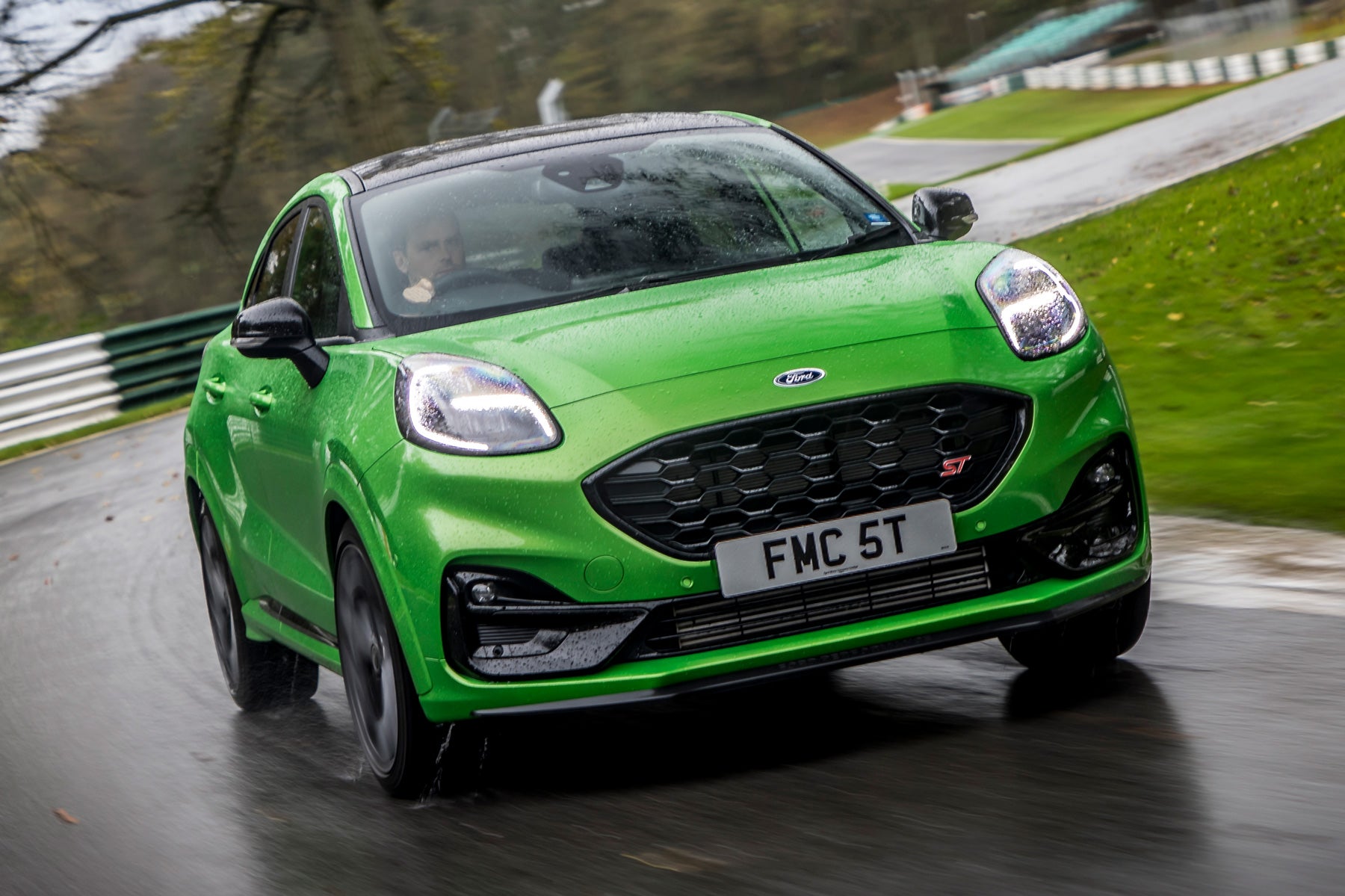Ford Puma ST Review 2025: Price, specs & boot space
Written by Ivan Aistrop
Quick overview
Pros
- Terrific fun to drive
- Amazingly practical boot
- Affordable to buy and run
Cons
- Most rivals have more power
- Ride is rather firm
- Disappointing auto version
Verdict: Is the Ford Puma ST a good car?
"The Ford Puma ST may not technically be a hot hatch, but it does exactly what the best hot hatches have traditionally done. It provides enough practicality for everyday transport duties in a package that’s fast and fun for those occasions when the kids aren’t on board, all in a package that’s affordable to buy and run."
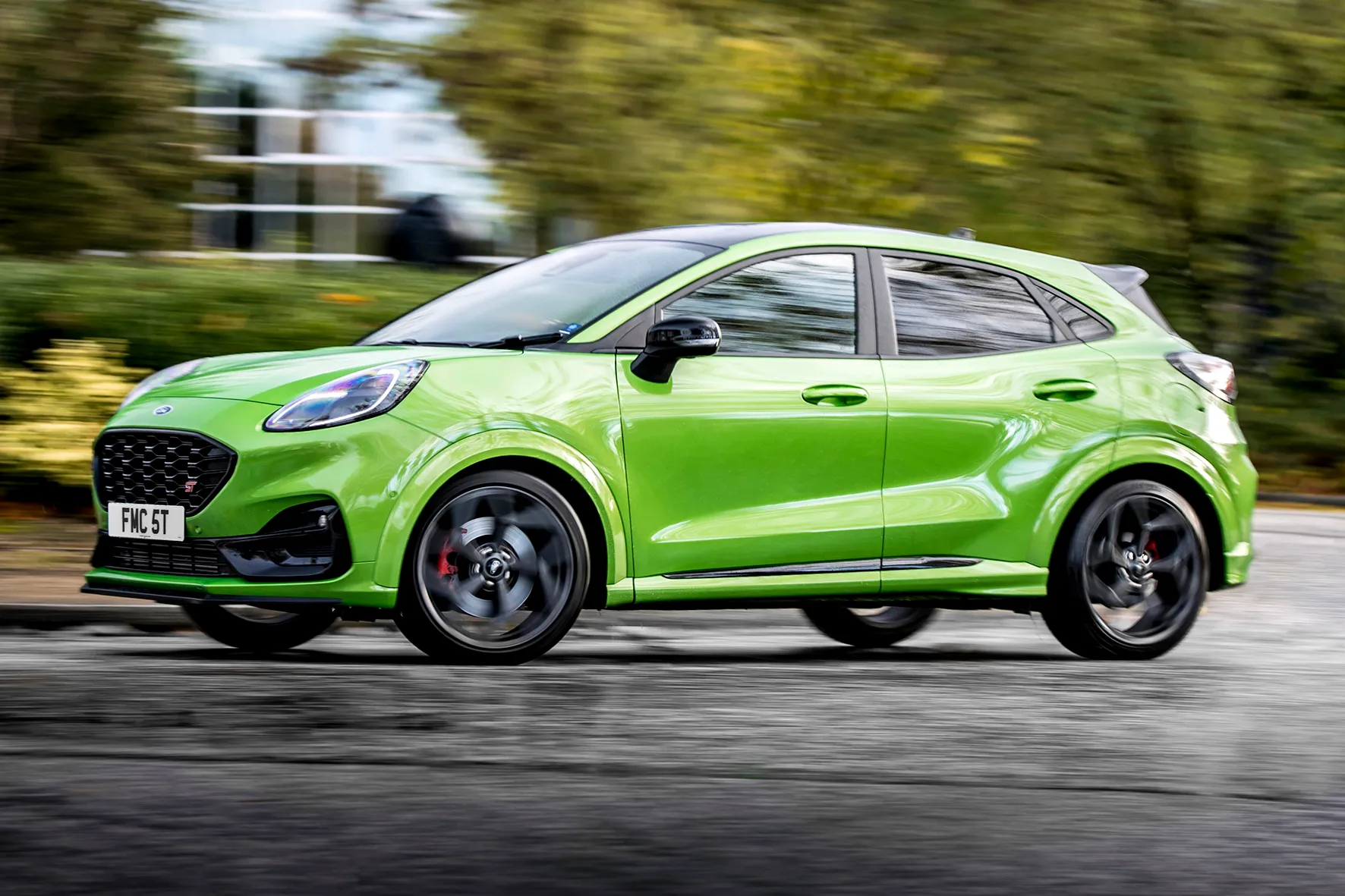
Society constantly reminds us about the merits of recycling, and the Ford Puma ST is a great example of how recycling can work wonders.
The Puma name is recycled for a start, from when it was first applied to a small sports coupe way back in the late ‘90s and now used for Ford’s entrant in the small SUV market.
The Puma ST’s mechanicals were also recycled, and thankfully, they were borrowed from just about the best source there is: the amazing – and sadly now defunct – Fiesta ST hot hatch. They had to be adapted slightly to cope with the Puma’s extra bulk – this is a bigger, heavier, taller car that is considerably more family-friendly – but happily, very, very little of the Fiesta’s dynamic magic was lost in the transformation.
Fire up the turbocharged 1.5-litre engine, and you’ll find that it not only makes a great noise, but it also feels strong and eager enough to have you grinning right from the get-go. The sweet shift action of the six-speed manual gearbox remains, as does the lightning-fast reaction of the pedals and the steering. All this combines with the wonderfully balanced chassis and super-tight body control to make this the best-handling and most entertaining car of its type, and by some distance. Yes, other fast SUVs are faster, but none are as much fun. You’ll have to decide for yourself whether or not you can live with the firm ride, which some will find too harsh for everyday use, but if you can put up with that, then you’ll adore the thrills it provides in compensation.
There’s one caveat: in 2023 Ford introduced an additional version of the ST with a less powerful mild-hybrid drivetrain and an automatic gearbox. We're not sure it deserves the 'ST' badge as performance is dulled and the automatic transmission just doesn't suit the car's sporting ambitions. Stick with the original recipe, though, and you’ll be getting a supremely enjoyable driver’s car for a super-competitive price. This is now the only Puma ST option for new buyers, which seems a shame.
It’s not just on the road where the ST dazzles. While passenger space is entirely adequate for a small family, the enormous boot – complete with some fiendishly clever touches – makes the Ford Puma ST a terrifically practical family car.
The cabin looks and feels every bit as posh and pleasant as those of most other cars in the sector, and most of the kit you’d expect is provided, although a few items you might expect as standard feature only on the options list.
Chuck in the excellent ergonomics, decent safety and a very compelling financial case, and you have an all-round package that’s strong in every area, and positively scintillating in all the most important ones. Thoroughly recommended.
Looking for a used car for sale? We've got 100s of Ford Approved Used Cars for Sale for you to choose from, including a wide range of Ford Puma STs for sale.
Is the Ford Puma ST right for you?
If you need the space and practicality of a family SUV but still want something that’s fast and fun to drive, then yes, the Ford Puma ST most certainly is right for you. It’s not the most powerful sporty SUV out there, and it’s not as fast as some as a result. However, it’ll be plenty brisk enough to have you grinning from ear to ear on every journey, and despite the performance deficit, it’s still more enjoyable and more engaging to drive than any rival because you can access so much more of its talents.
What’s the best Ford Puma ST model/engine to choose?
The Ford Puma ST is offered with a choice of two powertrains: a turbocharged 1.0-litre petrol mild hybrid with 170PS and an automatic gearbox, or a more powerful 1.5 turbo petrol with 200PS and a six-speed manual gearbox.
Now, we love the latter. The frenetic character of the engine in terms of both the performance it gives and the noise it makes suits the ST’s up-and-at-’em nature perfectly. The manual gearbox is a pleasure to use and lends the car an extra layer of interaction. Sadly, it's no longer offered as a new car.
On the other hand, the automatic transmission is still available and has less power. It takes too much away from the hot hatch recipe to leave much of a spicy flavour other than the looks. It’s barely any cheaper to run, either.
What other cars are similar to the Ford Puma ST?
The Ford Puma ST is something of a rarity. Virtually every manufacturer offers a small SUV of some variety, but not too many make a sporty one. Those that do tend to pack them with as much power as possible, much more than the Puma’s still very considerable 200PS. Those options include the Hyundai Kona N, the Volkswagen T-Roc R, the Audi SQ2 and the BMW X1 M35i, and they’re all way more expensive than the Ford. So, if you’re looking for something fast and fun, but still affordable, the Ford Puma ST has few peers. Even taking money out of the equation, the Puma ST is among the very best in this select segment.
Comfort and design: Ford Puma ST interior
"Perhaps not the poshest SUV of its type, and not the roomiest, either, but does a very competitive job in both areas. It’s boot space where the Ford Puma really impresses, though, and the extra underfloor storage area is a work of utter genius."
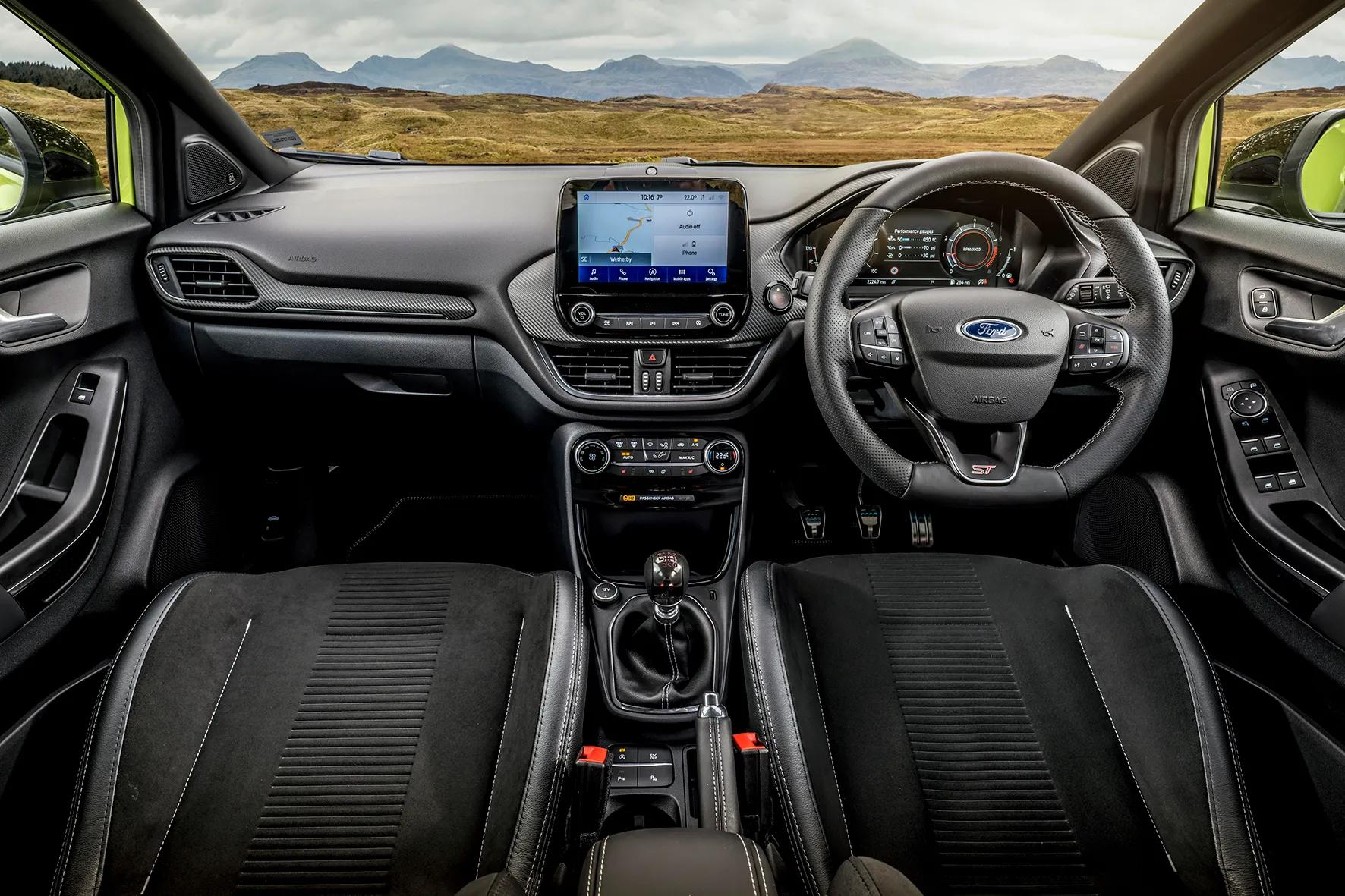
It’s easy to get comfortable at the wheel of the Ford Puma ST, thanks to the plentiful adjustment you get for both the steering column and the driver’s seat. Whether your preference is for the typical high-set position of an SUV, or the low-slung position of a hot hatch, the Puma can oblige – just crank your seat up or down to suit.
The seats themselves are also very supportive, with heavy bolstering to keep you in place under hard cornering, and adjustable lumbar support as standard. Add the fact that the steering wheel and pedals are perfectly aligned with your seat, and you have a driving position that’s just about spot on.
Visibility could be a bit better, however. Your view at the front quarters of the car is hampered slightly by the steeply angled windscreen pillars, while the thick pillars either side of the back window also mean over-the-shoulder visibility isn’t the clearest. However, front and rear parking sensors are standard, so parking manoeuvres shouldn’t be too much of a problem.
There’s a decent amount of storage in the Ford Puma ST's cabin, with a deep lidded cubby between the front seats, a couple of cup holders, deep door bins and a sizable glovebox. Most of the car’s functions are controlled via the car’s central touchscreen, which we’ll come back to in a moment. Happily, the ventilation system gets its own bank of dedicated physical controls so you don’t have to delve into endless on-screen submenus just to change the direction of the airflow. They’re logically placed and easy to use, and the same goes for the small amount of other switchgear to be found in the Puma’s cabin.
Quality and finish
This is an area in which the Ford Puma ST impresses. Sure, the interior isn’t particularly colourful, but it is pleasant, with some squishy, high-grade materials to be found in important places – like on top of the dashboard and doors – and a leather finish for the steering wheel and gear lever. What’s more, there are a few other carefully chosen trims and textures dotted around to mix things up a bit and keep things interesting.
It is true that as you probe lower down and further back in the cabin, the quality of the materials used does drop off a bit. However, that’s also true of the vast majority of the Ford Puma ST’s small SUV rivals, so it’s forgivable here.
Infotainment: Touchscreen, USB, nav and stereo in the Ford Puma ST
The Ford Puma ST started out with a SYNC3 infotainment system, and the good news is that it’s cracking. It combines a clear and attractive 12.3-inch digital driver’s display with an 8.0-inch central touchscreen, and works brilliantly thanks to logical menus, large on-screen icons and slick graphics. It also supports all the functionality you expect, including navigation, DAB radio, Apple CarPlay and Android Auto. You get wireless phone charging, as well as a couple of USB ports and a ten-speaker Bang & Olufsen sound system as standard, giving crystal-clear sound.
That was for the manual version and earlier automatic cars. Now, the Puma ST as a new car comes with a 12-inch infotainment display set in a landscape orientation. It comes with Apple CarPlay and Android Auto, premium Bang & Olufsen stereo, navigation, FordPass Connect, and Emergency Assistance included. There's also a wireless charging pad, plus a 12.8-inch digital instrument screen.
Space and practicality: Ford Puma ST boot space
This is definitely an area of strength for the Ford Puma ST, which is important given that most Pumas will be used as family cars. There’s lots of space up front and very competitive space in the rear seats as well. Six-foot adults will fit with relative ease, although you won’t want to squeeze three people across the rear bench on a regular basis. If you’re carrying children, there’ll be space to spare. It’s not class-leading back there for roominess, but it is competitive.
Special praise must be reserved for the Ford Puma ST’s boot. With 456-litres of capacity, it’s not only one of the biggest load areas in the class, but it also has the measure of many cars from the class above. And it’s not just big, it’s clever, too. Lift up the boot floor and you’ll find what Ford calls the ‘Megabox’, which is an 80-litre storage space that’s lined with waterproof plastic and has a drain plug in the bottom. That means you can fill it with ice and use it as a drinks cooler, or more likely use it to store muddy wellies safe in the knowledge that you can hose it out later.
With the false floor in place, you also get a stepless load area when you drop the 60/40 split-folding rear seats. What’s more, the backrests lie flat and level, which makes the space even more usable.
Handling and ride quality: What's the Ford Puma ST like to drive?
"The Ford Puma ST is by no means the fastest sporty SUV out there – many rivals outstrip it by quite a distance for pace – but it’s more enjoyable to drive than any of them thanks to its wonderfully crisp handling. Just make sure you can live with the firm ride."
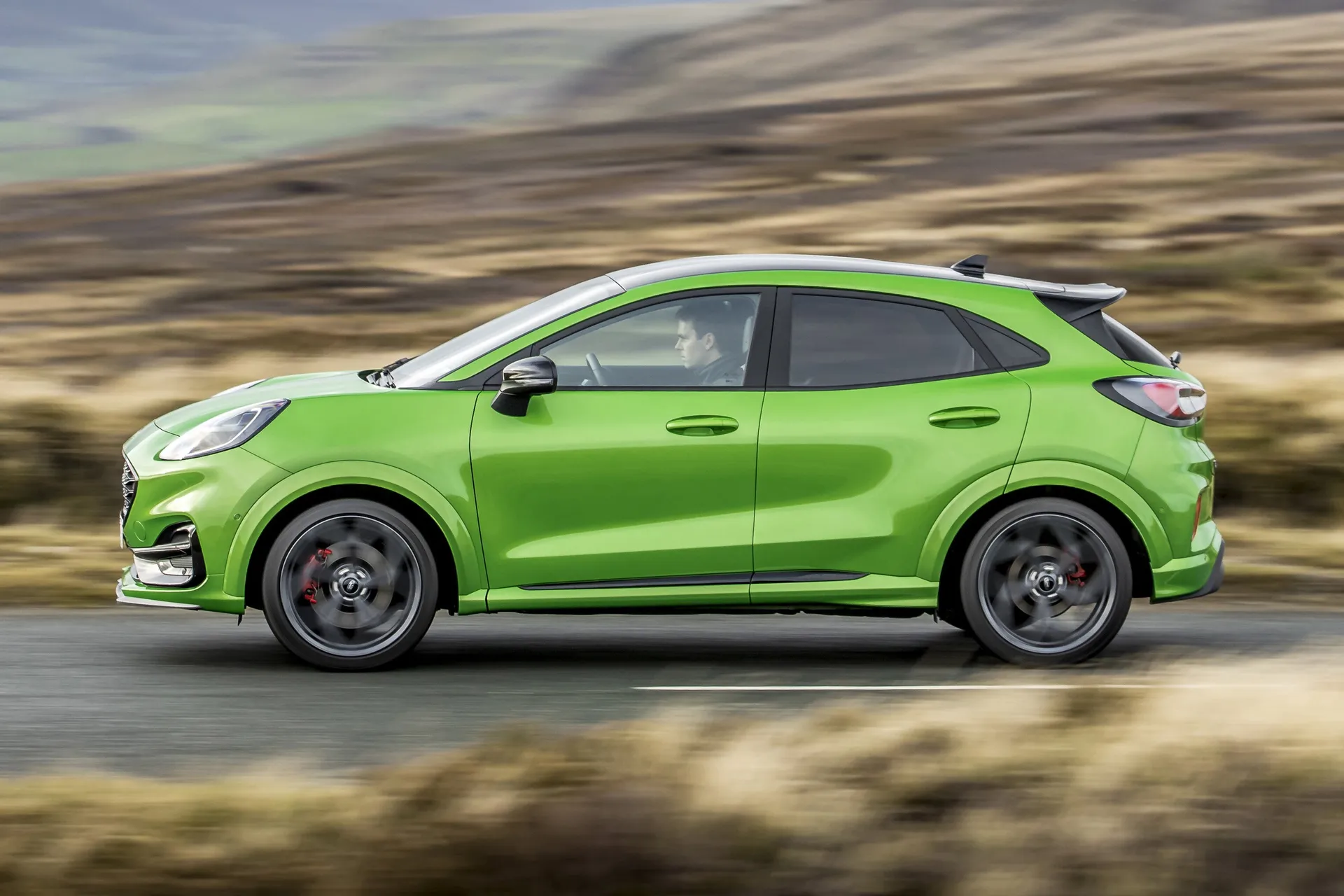
Handling is the one area where any small sporty car should excel, and happily, it’s precisely the area in which small sporty Fords have been excelling for years. Even more happily, the Puma is no exception to that rule.
It’s not just the strong grip from the front tyres, the rock-solid body control, or the way that the super-fast steering darts the nose of the car quickly into corners. It’s also the predictability and adjustability you get from such a wonderfully balanced chassis, one that it shares with the now-defunct Fiesta ST.
There are differences, and it’s true that the Puma ST isn’t quite the dynamic equal of the Fiesta ST, although the fact that Ford’s engineers have got it so close when faced with the obstacles of physics is something of a miracle in itself.
It’s bigger, heavier and taller for a start, which means weight transfer inevitably isn’t as crisp as it is in the Fiesta, but you’d need to drive the two cars back-to-back to detect any difference, and even then, most drivers would struggle to tell. Rest assured, there’s no shortage of fun, and the Puma ST is much more of a hoot to drive than any sporty SUV rival.
The pin-sharp steering, meanwhile, is great when slicing through corners, but it can feel a little oversensitive in other situations, so you have to keep your wits about you to plot a smooth, straight course. It’s the same in the Fiesta, but it’s somehow more forgivable in a smaller, lower car.
The same goes for the firm ride you get from the stiffened and lowered suspension. Some people will find it tolerable, but others will find it too jarring for too much of the time. We recommend an extensive test drive before you buy to see which camp you fall into. If you can put up with it, though, you’ll have a car that will make you smile every single day, on every single journey.
What engines and gearboxes are available in the Ford Puma ST?
For the earlier part of its existence, the Puma ST was available with a single powertrain, the same one found in its hot hatch sibling, the Fiesta ST. The 1.5-litre three-cylinder turbocharged petrol engine, teamed with a six-speed manual gearbox, punts out an identical 200PS, but torque was increased slightly from 290Nm to 320Nm to account for the Puma’s bulkier bodywork.
As such, the Puma ST matches the Fiesta’s 0-62mph sprint time of 6.7 seconds, and if speed limits weren’t an issue, it would keep going all the way up to a top speed of 137mph. More important than the numbers, though, is the way it feels, and the car feels every bit as fizzy and as eager as you'd hope, building speed quickly and consistently.
It’s not just the power that makes it special. The short, sharp-shifting action of the six-speed manual gearbox makes it an absolute joy to operate and adds a further level of engagement, while the pin-sharp pedal response also adds to the feeling of immediacy. It may not be the fastest car of its type, but it's as enjoyable as anything else when rushing towards the horizon. Be in no doubt, the Puma ST will join the pantheon of great fast Fords.
In late 2023, a little while after the Fiesta had been discontinued so that Ford could concentrate on production of the Puma, an additional version of the ST was released. It has a tuned-up version of the same 1.0-litre, three-cylinder turbocharged petrol engine found lower down in the Puma range, teamed with mild-hybrid assistance and a Powershift twin-clutch automatic gearbox.
This powertrain has a steady-state power output of 160PS, which can be temporarily hiked to 170PS for short periods by an overboost function. When overboost and the mild-hybrid assistance are both in full effect, torque is hiked from 200Nm to 248Nm. It has a 0-62mph time of 7.4 seconds and a top speed of 130mph.
While the handling is identical to the 1.5-litre version, the performance and its delivery leave a lot to be desired. It just doesn't zing in the same way or feel as urgent, even though the shifts in the auto 'box are smooth. However, the automatic transmission doesn't let the Puma ST pull away from a standstill without a jerky take-up of power. For race starts it's ideal, but in the normal ebb and flow of daily driving it's a massive pain and one we found nigh-on impossible to avoid regardless of how we drove. That, plus the over-large 'squircle' steering wheel needed to give a clear view of the digital dash, spoil the overall Puma ST experience in this version that is now the only choice of new car buyers.
Refinement and noise levels
You want a bit of noise in a sporty car like the ST, provided it comes from the right source, and at the right time. Happily, the Ford obliges. The 1.5-litre engine stays smooth and subdued when you’re just pootling along, but when the revs rise, it gives off a pleasant burble that adds to your excitement levels even further. It's the same story with the 1.0-litre unit, though it does have to be worked a bit harder. Even so, it's never uncouth and is, if anything, maybe a touch too refined.
Wind noise isn’t at all bad given the Puma’s slightly-taller-than-normal stance, and although the chunky tyres do generate a bit of road noise, it isn’t offensive at any speed.
Safety equipment: How safe is the Ford Puma ST?
The Puma has actually been tested by safety experts Euro NCAP twice. In the first test in 2019, it achieved the full five-star rating, but because it’s one of the biggest-selling models around, it was retested in 2022 under the safety body’s more recent, more stringent standards. This time it received only a four-star rating, largely because the car has neither a central airbag nor an eCall emergency response system.
What it does have, however, is automatic emergency braking, lane-keep assist and lane-departure warning, along with a post-collision braking system that locks the anchors on after a smash to minimise the risk of further collisions.
You also had the option of adding a Driver Assistance Pack at extra cost (it’s quite reasonably priced) for the 1.5-litre model. This adds active park assist and a rear-view camera, along with adaptive cruise control with stop-and-go function in traffic. This pack is now included as standard with new Puma STs.
MPG fuel costs: What does the Ford Puma ST cost to run?
"The full-fat Puma ST is comparable with its hot-hatch rivals for fuel economy, so probably won’t cost you any more to run overall. However, don’t go expecting the mild-hybrid version to be some sort of fuel-sipping eco-warrior, because it doesn’t actually do that much better."
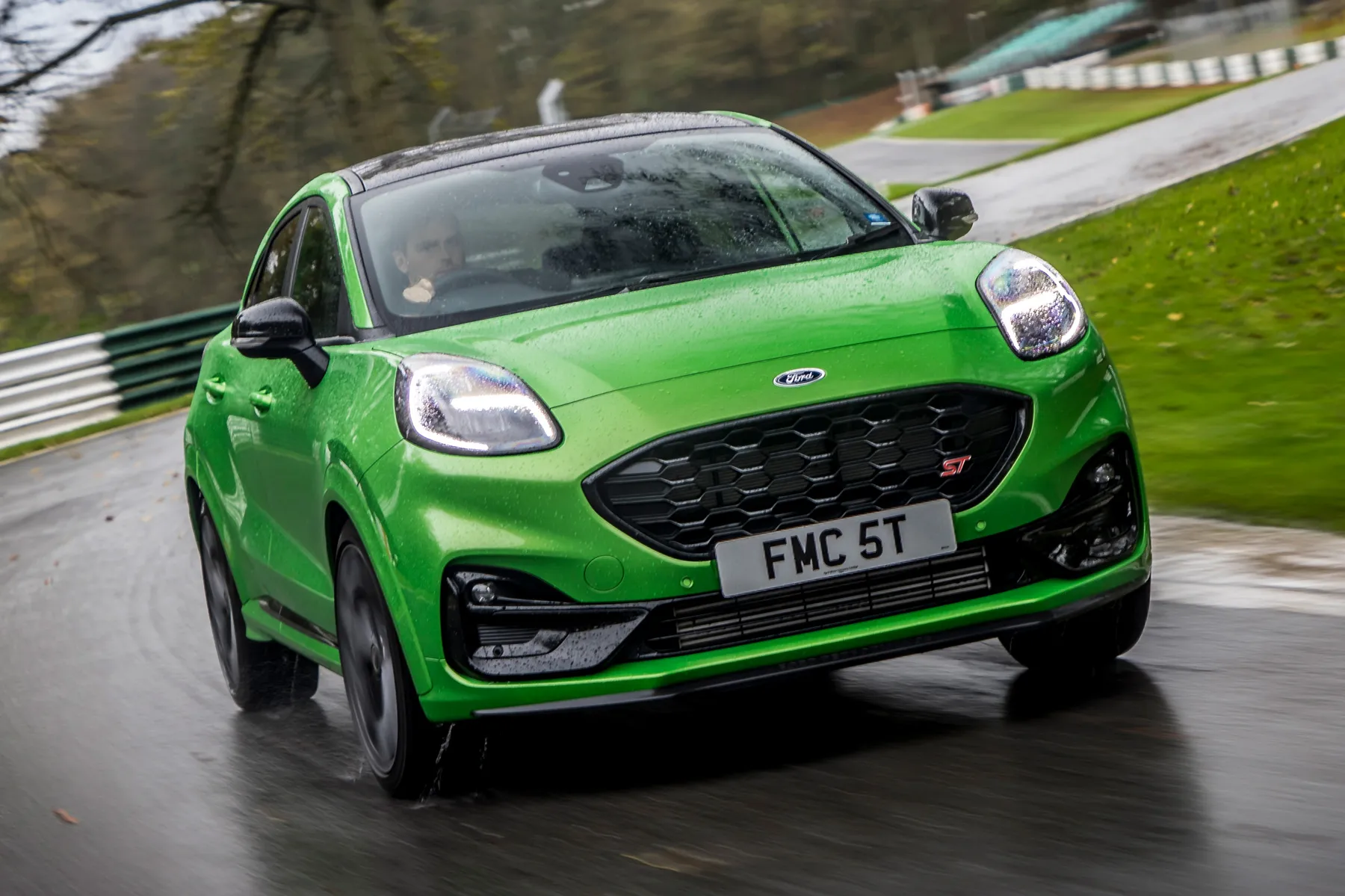
The more powerful 200PS manual version of the Puma ST has an official fuel-economy figure of 42.8mpg. That’s slightly better than the 40mpg offered by the similarly powered Hyundai i20 N, but it’s some way sort of the 50mpg offered by the Suzuki Swift Sport mild-hybrid, but in fairness, that car is down on power by a considerable amount. Real-world driving will deliver mid-30s fuel economy in our experience.
The mild hybrid version of the Ford Puma ST has less power, with a maximum output of 170PS (but it’s still pokier than the Swift with 129PS) so it might be a little surprising that doesn’t do a little better on fuel economy, with an official figure of 44.8mpg. That figure was later amended by Ford to 47.9mpg, but high 30s is what we've seen in normal driving.
Ford Puma ST reliability and warranty
Ford didn’t exactly cover itself in glory in the latest HonestJohn.co.uk Satisfaction Index, being named as the seventh most unreliable manufacturer in the study (out of 29). The Puma itself didn’t come in for criticism, with most of it being aimed at the bigger Kuga, but the 2017 to 2023 version of the Fiesta hatchback was also named and shamed for its disappointing reliability, and worryingly, the Puma shares its mechanical parts with that very car.
Ford Puma ST insurance groups and costs
Buy the Ford Puma ST manual with the bigger engine, and your car will sit in group 22 for insurance, while the mild-hybrid version is in group 21. Since the most affordable insurance group is group 1 and the most expensive is group 50, that means you can expect middling premiums for the Puma ST, which is fair enough given its power.
To be fair, that looks pretty good compared with rivals such as the Hyundai i20 N, which has similar power but sits in group 27. It looks even better compared with the Suzuki Swift Sport, which has considerably less power but inexplicably manages to sit in groups 28 to 35.
VED car tax: What is the annual road tax on a Ford Puma ST?
Buy a brand new Ford Puma ST and it will be the hybrid model with carbon dioxide emissions of 135g/km. That means a first-year road tax bill of £540. However, the car's list price means you won't have to worry about paying the levy for new cars costing more than £40,000.
The 1.5-litre model and, when it reaches its first birthday, the hybrid will pay the standard £195 for a year's road tax.
Ford Puma ST price
"Compared with its performance SUV rivals, the Puma ST already looks like a bargain thanks to its comparatively low prices. However, browse our listings for a used example and you can save a substantial amount."

A four-year old Ford Puma ST 1.5 EcoBoost with 35,000 miles under is nose will cost you just less than £18,000. That seems like keen value to us, or you could aim for a newer version with the 1.0-litre petrol-hybrid engine and less than 10,000 miles on the dials for a little over £25,000.
Look for a nearly new or pre-registered Ford Puma ST and savings of £2300 or more are easily achieved.
Trim levels and standard equipment
As the sportiest version of the Puma, the ST looks the part with a racy bodykit, 19-inch alloy wheels, LED lighting all round and rear privacy glass. Meanwhile, convenience features include power folding door mirrors with puddle lamps, a Quickclear heated windscreen, keyless entry and start, climate control, sports seats, part-leather-effect upholstery, heated front seats and steering wheel, automatic lights and wipers, front and rear parking sensors, and manual cruise control.
It cost extra to add the Driver Assistance Pack to the 1.5-litre model, which brought adaptive cruise control with stop-and-go function in traffic, plus the pack also gives you active park assist and a rear-view camera. This is now standard on the 1.0-litre mild hybrid model when you buy new.
For new buyers, there is also the option of the ST Handling Pack that brings different 19-inch alloy wheels, KW suspension, a black-painted roof, illuminated front scuff plates, and a round steering wheel. While we're not sure why you should have to add a handling pack to a performance model, we'd gladly pay for the proper circular steering wheel over the squared-off version that's standard.
Ask the heycar experts: common questions
Is the Ford Puma ST a good car?
How much does a Ford Puma ST cost?
What’s the engine in a Ford Puma ST?
Get our latest advice, news and offers
Keep me updated by email with the latest advice, news and offers from heycar.
By submitting you agree to our privacy policy
